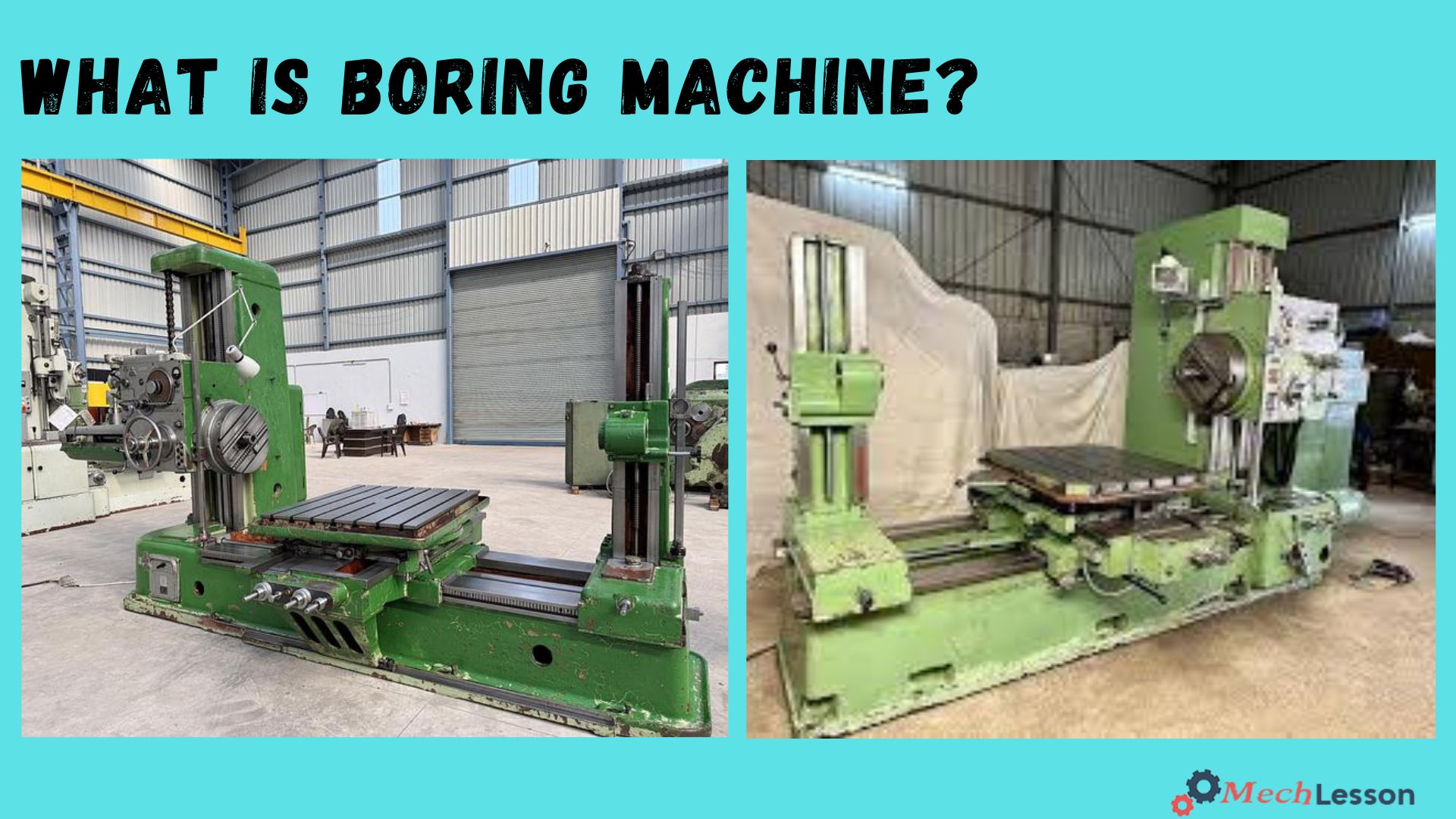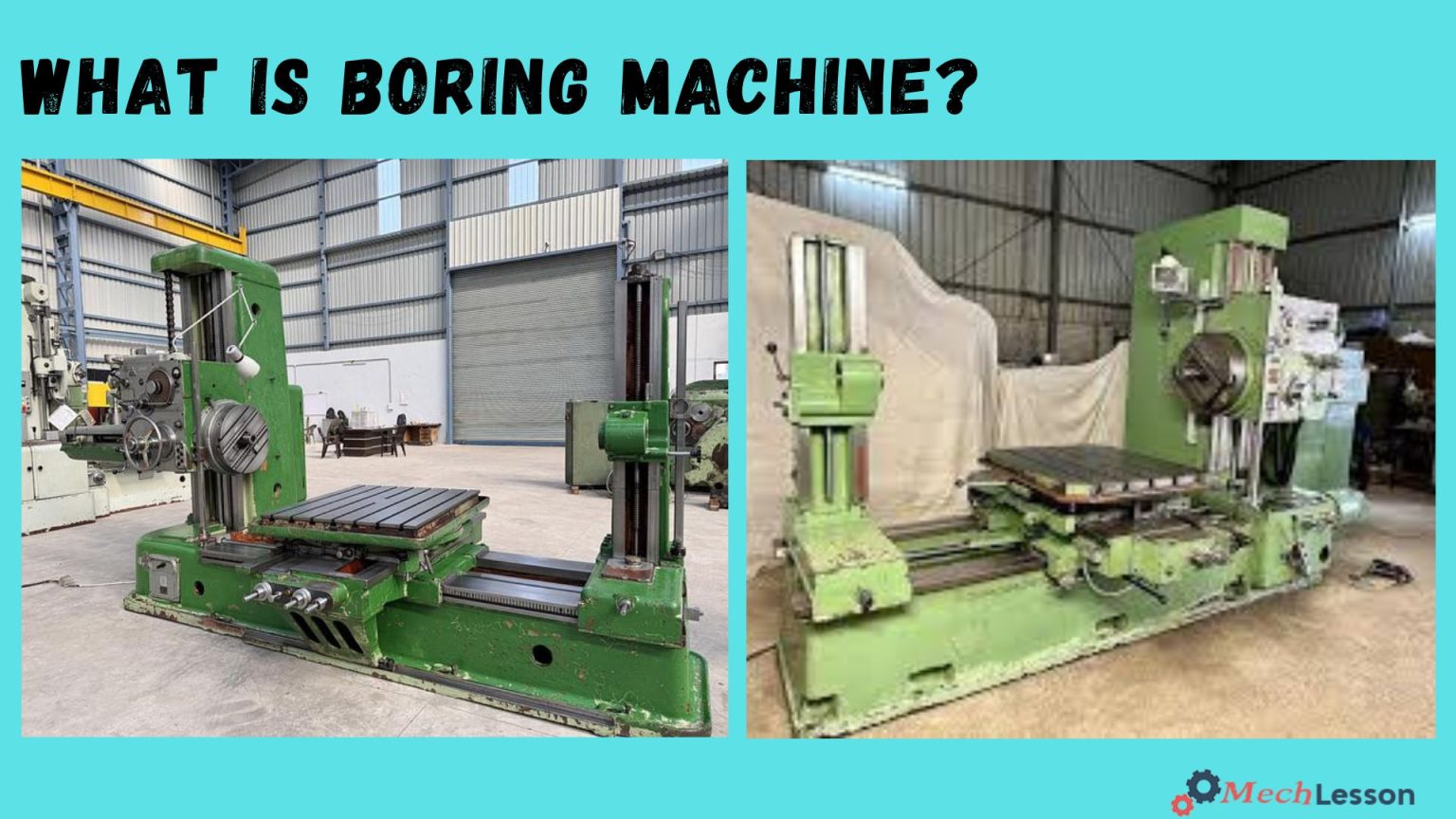Boring machines are essential and versatile tools used in various industries and manufacturing processes. They play a critical role in drilling and machining precise holes in different materials using specialized cutting and boring tools.
Boring machining is a highly precise process used to enlarge an existing hole in a workpiece with the help of a single-point cutting tool or boring bar.
This method ensures exceptional dimensional accuracy and surface finish, making it indispensable in industries that demand precision.
Well, in this reading, we’ll explore what a boring machine is, its applications, parts, diagram, types, and how it works. We’ll also explore the boring machining process as well as its advantages.
Let’s begin!
Learn about Grinding Machine with this detailed guide!
What is a Boring Machine?
A workpiece’s existing holes can be enlarged or refined using the precision-driven process of boring machining, which frequently requires high levels of accuracy and dimensional consistency.
Boring machining focuses on improving the size and surface polish of pre-existing holes, as opposed to drilling, which makes the initial hole. To accomplish desired results in machining operations, the procedure makes use of a variety of boring equipment and tools, including the cutting tool and boring bar.
This method is essential in manufacturing, where accuracy and precision are important, and it guarantees that machining operations adhere to standards and specifications.
Boring machining may yield highly precise and accurate results with the use of CNC machining and other cutting-edge technologies, which are essential in the production of engine components and other vital parts.
Prior to the invention of boring machines, carpenters drilled holes with hand-powered augers. T-handled augers were the most often used.
Prior to the development of the spiral or twist bit in 1771, which removes the cuttings as it rotates, the spoon bit and shell bit were widely used drill bits.
Although the precise creation of this innovation is unknown, J. Beckwith received the first patent for it in the United States in 1830. It was as tall as a man and was driven by a big wheel on the side.
The twist auger bits used in boring machines are typically between 7/8 and 2 inches in size. To prevent the machine from moving, the operator sits on the base and uses both hands to run the machines, which hold the bit square and perpendicular to the face of the lumber.
It is possible to position some machines at an angle.
Learn about Drilling Machine with this detailed guide!
Applications
Boring machines play a crucial role across a wide range of industries, valued for their precision, accuracy, and efficiency in enlarging holes and tunnels. Well, below are some areas where boring machines are widely used:
- Line boring machine: Used in heavy construction equipment like cranes and end loaders.
- Tunnel boring machine: can drill bores in hard rock and sand, producing a smooth tunnel wall.
- Horizontal boring machine: time-saving for rigid construction.
- Directional boring machine: Includes a frame and a slideable drive mechanism.
- Cylinder boring machine: Used for reboring engine cylinders in automobiles.
- Jig boring machine: accurately enlarges existing holes and makes their diameters.
- Portable boring machine: flexible, powerful, and easy to use.
- Vertical boring machine: designed for manual vertical drilling.
- Coupling boring machine: bores precision couplings.
Major Parts of a Boring Machine
Boring Machine Components Overview
• Base or body: it gives shape and balances the device.
• Spindle: is used to rotate the reducing device to create holes.
• Cutting tool: can be a drill, dull bars, or special equipment.
• Worktable: helps in workpiece movement and ensures precise drilling.
• Coolant device: used to reduce drilling heat and lubricate the cutting tool.
• Base: made of cast iron or metal for pressure and stability.
• Spindle: is driven by an electric motor; it rotates the reducing device at high speeds.
• Lowering device: made of high-speed steel or carbide to resist high temperatures and pressures.
• Worktable: Can be moved in various directions for creating unique holes.
You should also learn about Lathe Machine with this detailed guide!
Diagram

Types of Boring Machines
Below are the most common types of boring machines across different fields:
- Horizontal boring machines: used for creating massive holes in heavy workpieces and are used in large structures like bridges and homes.
- Vertical boring machines: used for creating holes in smaller workpieces, used in engine blocks and vehicle components.
- Deep-hole boring machines: used in manufacturing gun barrels and hydraulic cylinders.
- Tunneling machines: used in transportation and mining tunnels, capable of drilling through various soil and rock types.
- Jigborers: used in aerospace for high-precision component manufacturing.
You should also learn about Capstan And Turret Lathe with this detailed guide!
How Does Boring Machining Work?
By using a bore to enlarge preexisting holes, a boring machine creates precise and clean holes in a workpiece. A single cutting point made of steel, cemented carbide, diamond, or maybe a tiny grinding wheel might be inserted into the hole.
Single-point tools are pushed in a circular motion against the sidewalls of the preexisting holes while being held in a boring head that is connected to a rotating spindle. By adjusting the boring head, the tool can control the width of the hole it cleared out.
In order to manage the hole diameter, the distance between the wheel and spindle axis is adjusted. Grinding-wheel cutters revolve quickly around their axes, which then slowly rotate with the boring head about the spindle axis.
On boring machines, the spindles can revolve around either vertical or horizontal axes.
In order to precisely place holes, boring machines used in toolmaking industries contain a single vertical spindle and a work-holding table that may be moved horizontally in two directions perpendicular to one another.
The spacing inaccuracy is less than 0.002 percent on certain devices. Special boring machines with many spindles are frequently seen in mass-production facilities.
Learn about Milling Machine with this detailed guide!
Conclusion
A boring machine is a crucial tool in manufacturing, used to enlarge or refine existing holes with exceptional accuracy and surface finish. Whether it’s a horizontal, vertical, or CNC boring machine, each type serves unique industrial applications ranging from automotive to heavy machinery.
Understanding how a boring machine works and its types allows manufacturers to choose the right equipment for precise internal machining, boosting productivity and component quality.
Frequently Asked Questions (FAQs)
What is a boring machine used for?
A boring machine is used to enlarge existing holes and achieve high precision in internal diameters in metal or other materials.
What are the types of boring machines?
- Horizontal Boring Machine
- Vertical Boring Machine
- Jig Boring Machine
- CNC Boring Machine
- Tunnel Boring Machine (for civil works)
How does a boring machine differ from a drilling machine?
Drilling creates new holes, while boring enlarges or finishes an existing hole for better precision and alignment.
What industries use boring machines?
- Automotive
- Aerospace
- Shipbuilding
- Heavy equipment
- Civil engineering (for tunnels)
What is a horizontal boring machine?
It is a machine where the spindle is mounted horizontally. It’s used for boring large and heavy workpieces.
What is a vertical boring machine?
A vertical boring machine has a vertically mounted spindle and is ideal for machining large, heavy cylindrical parts.
What is CNC boring?
CNC (Computer Numerical Control) boring machines offer automated, programmable boring operations with high precision and repeatability.
What materials can be machined with boring machines?
Typically used for metals such as steel, aluminum, cast iron, and sometimes plastics.
What is a boring tool used for?
A boring tool is a type of cutting instrument used for boring, commonly employed in internal hole machining, hole enlargement, and internal contour imitation. It consists of one or two cutting parts, specifically designed for the rough, semi-finish, or finish processing of existing holes.
What is the difference between a drilling and boring machine?
drilling uses a variety of drill bits made for particular materials and applications; boring uses specialized instruments like boring bars, boring heads, and inserts for precision work.
Boring is the best method for jobs requiring tight tolerances since it eliminates material precisely and progressively.
What are the machines used in boring?
A cylinder boring machine is mainly used for reboring engine cylinders in automobiles. A jig-boring machine is used to accurately enlarge existing holes and make their diameters highly accurate. They perform operations such as drilling, boring, and counter-sinking holes in metal work pieces.
What is the main purpose of boring?
Boring is used to achieve greater accuracy of the diameter of a hole and can be used to cut a tapered hole. Boring can be viewed as the internal-diameter counterpart to turning, which cuts external diameters.

